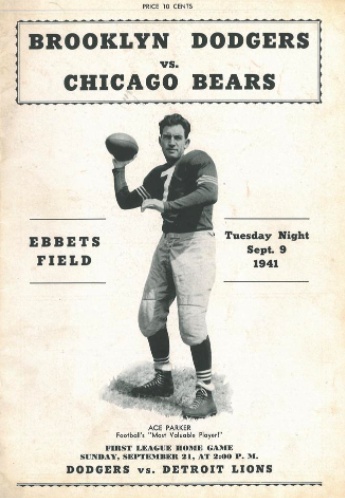Unraveling the Origin of Coaches Viewing Football Games from the Stands
1/16/2018
The eye in the sky doesn’t lie, but it may stretch the truth a little sometimes to make for a better story. Before the days when every team in the National Football League had 10 or more people coaching from the press box, Chicago Bears assistant coach Luke Johnsos grabbed a seat in the stands during a 1941 exhibition game between the Bears and the Brooklyn Dodgers at Ebbets Field, hoping for a better view. The way the story has been told through the years by some reputable news sources is that this was the beginning of coaching from above. Apparently, at some point, Johnsos decided to start drawing up plays and throwing them down to the sideline to be used in the game.

As it was described by both the Saturday Evening Post in 1941 and then again by the New York Times in 1960, when Johnsos thought a certain play would work he drew it, balled it up, and tossed it down to the sideline where a young kid picked it up to deliver the play. According to the story, the very first play Johnsos drew up resulted in a 47-yard run by Hall of Fame halfback George McAfee to set up a touchdown.
By the time Johnsos was ready to send down the next play, though, the Ebbets Field crowd had caught on. Just as Johnsos threw his play down from the upper deck, the irate crowd tossed their crumpled scorecards to the sideline as well. The Bears never received the second message and the clean-up crew swept it up and hauled it away the next day with all the other trash.
With so many offensive and defensive coordinators calling plays from the press box in recent history, it doesn’t seem farfetched to think this is how the coaching trend all got started.
However, like many folklores throughout the history of professional football, while there is some truth to the tale it didn’t happen quite the way it was reported. Fake news? Not quite, but after extensive research in the Ralph Wilson, Jr. Pro Football Research and Preservation Center, the truth was revealed.
As great of a story as that might have been, when asked later about Johnsos’s new coaching method, both McAfee and the Bears’ Hall of Fame quarterback Sid Luckman laughed hysterically. Luckman even explained Johnsos would send down plays, but they weren’t passed along to the quarterback at that time. According to Luckman, the team would find out about the plays during timeouts. Remember, this was still during the era when sideline coaching was illegal and even though subs could relay information to the huddle, the player he subbed for had to sit out the rest of the half.
To further dispel the myth, McAfee’s 47-yard run, which supposedly set up one of Chicago’s two touchdowns never happened. McAfee did, however, score both of the Bears touchdowns in their 14-9 victory over the Dodgers, but one came via a fumble recovery and the other a punt return.
While coaching from the stands was unusual during the 1940s, and Luke Johnsos was certainly a pioneer of press box coaching, he wasn’t the first. Actually, the Bears and Johnsos may have even gotten the idea from one of their opponents during the 1934 NFL Championship Game game against the New York Giants. The New York Times reported Columbia coach Lou Little watched the game from the stands and was seen phoning to the New York bench throughout the game. Was Little really talking to the Giants coaches or just another case of facts getting in the way of a good story?
Regardless, here inside the Pro Football Hall of Fame’s Archives, among the 40 million pages of documents and six million photographic images, the truth is preserved and waiting to be discovered and revealed.
Go back to all blog listings

